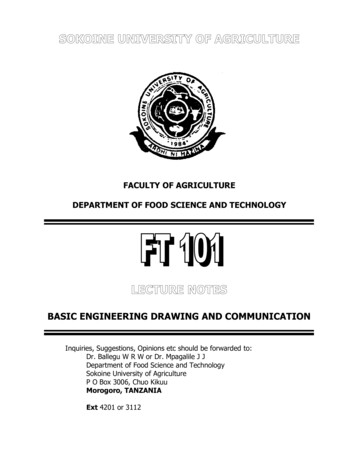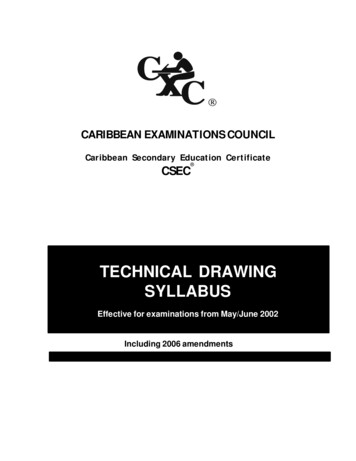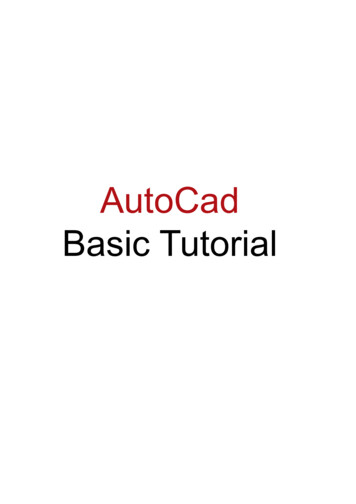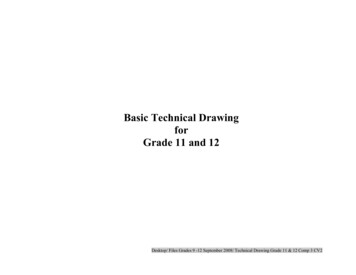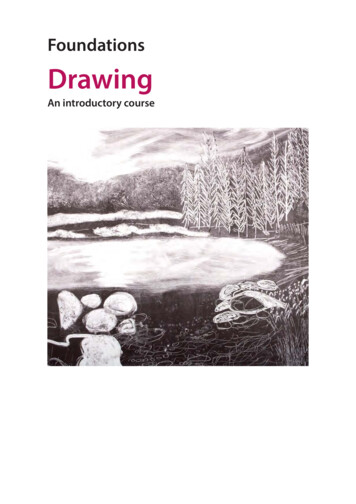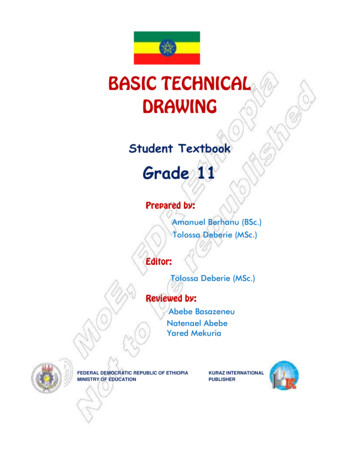
Transcription
BASIC TECHNICALDRAWINGStudent TextbookGrade 11Prepared by:Amanuel Berhanu (BSc.)Tolossa Deberie (MSc.)Editor:Tolossa Deberie (MSc.)Reviewed by:Abebe BasazeneuNatenael AbebeYared MekuriaFEDERAL DEMOCRATIC REPUBLIC OF ETHIOPIAMINISTRY OF EDUCATIONKURAZ INTERNATIONALPUBLISHER
AcknowledgementsThe redesign, printing and distribution of this student textbook has been funded through theGeneral Education Quality Improvement Project (GEQIP), which aims to improve the quality ofeducation for Grades 1–12 students in government schools throughout Ethiopia.The Federal Democratic Republic of Ethiopia received funding for GEQIP through credit/financingfrom the International Development Associations (IDA), the Fast Track Initiative Catalytic Fund(FTI CF) and other development partners – Finland, Italian Development Cooperation, the Neth‐erlands and UK aid from the Department for International Development (DFID).The Ministry of Education wishes to thank the many individuals, groups and other bodies in‐volved – directly and indirectly – in publishing the textbook and accompanying teacher guide.Every effort has been made to trace the copyright holders of the images and we apologise in ad‐vance for any unintentional omission. We would be pleased to insert the appropriate acknowled‐gement in any subsequent edition of this publication. Federal Democratic Republic of Ethiopia, Ministry of EducationFirst edition, 2003(E.C.)Developed, printed and distributed for the Federal Democratic Republic of Ethiopia, Ministry ofEducation by:Al Ghurair Printing and Publishing House CO. (LLC)PO Box 5613DubaiU.A.E.In collaboration withKuraz International Publisher P.L.CP.O. Box 100767Addis AbabaEthiopiaISBN: 978‐99944‐2‐094‐0All rights reserved. No part of this publication may be reproduced, stored in a retrieval system ortransmitted in any form or by any means (including electronic, mechanical, photocopying, record‐ing or otherwise) either prior written permission of the copyright owner or a licence permittingrestricted copying in Ethiopia by the Federal Democratic Republic of Ethiopia, Federal Negarit Ga‐zeta ,Proclamation No. 410/2004 Copyright and Neighbouring Rights Protection Proclamation,10th year, No. 55, Addis Ababa, 19 July 2004.DisclaimerEvery effort has been made to trace the copyright owners of material used in this document. Weapologise in advance for any unintentional omissions. We would be pleased to insert the appro‐priate acknowledgement in any future edition.
Table of ContentsPageUNIT 1. INTRODUCTION TO BASICTECHNICAL DRAWING . 11.1 History of Drawing . 21.2 Areas/Professional Disciplines of Technical Drawing . 31.3 Technical Drawing Today (Computer Aided Design and Drafting) . 41.4 Use and Educational Value of Technical Drawing . 4UNIT SUMMARY . 5UNIT 2. BASIC TECHNICAL DRAWING EQUIPMENT . 62.1 Introduction . 72.2 Selection of Drawing Materials . 72.3 Selection of Drawing Instruments . 112.4 Application of Basic Technical Drawing Equipments . 17UNIT SUMMARY . 26UNIT 3. ALPHABET OF LINES. 323.1 Introduction . 33UNIT SUMMARY . 37UNIT 4. LETTERING . 404.1 Introduction . 414.2 Technique of Lettering . 424.3 Single Stroke Letters . 434.4 Guide Lines . 474.5 Uniformity, Stability and Composition of Lettering . 49
4.6 LeRoy Lettering and Lettering Template/ Guide . 52UNIT SUMMARY . 53UNIT 5. GEOMETRIC CONSTRUCTION . 585.1 Introduction . 595.2 Construction of Point, Line and Angle . 595.3 Polygons . 665.4 Circles and Tangents . 735.5 Construction of an Ellipse . 79UNIT SUMMARY . 82UNIT 6. MULTI-VIEW DRAWING . 846.1 Introduction . 856.2 Projection . 856.3 Orthographic Projection . 866.4 The Six Principal Views . 896.5 Fundamental Views of Edges and Surfaces . 956.6 Visualization . 101UNIT SUMMARY . 106UNIT 7. PICTORIAL DRAWING . 1157.1 Introduction . 1167.2 Axonometric Projection . 1207.3 Oblique Projection . 1347.4 Perspective Projection . 142UNIT SUMMARY . 152
1 Introduction to Basic Technical DrawingUNIT1Introduction toBasic TechnicalDrawingEngineers use drawings tocommunicate ideas tocolleagues and co-workersLearning Competencies:Upon completion of this unit, you should be able to: Define drawing in your own words ; Write the role of drawing in human civilization; Explain how and when drawing originated; Distinguish the two classification of drawing; Describe the areas / professional disciplines of technical drawing; Describe some important applications of technical drawing in everyday life; State the advantage of CADD in related manual work; Explain the educational value of technical drawing.1
1 Introduction to Basic Technical Drawing1.1History of DrawingFor what purpose drawing is used around yourschool or around your city?People learned to draw pictures of theobjects around them long before they learnedto write. The ability to make simple drawingshelped people develop their first writtenlanguage. There were no words or charactersin ancient writing. Ideas of things wereconveyed by pictures of the battles, andhunting was recorded in these “picture”languages. Drawings carved by primitivepeople on rocks, walls of caves and so forthhave survived to our day.Many drawings of human beings, animals,fish and so on, made by our forefathersthousands of years ago, have been found onthe eastern shore of lake Onega and on theshores of the White Sea. These drawingswere carved on granite rocks with stone (flint)tools. (Fig.1.1)History indicates that drawings were used inancient times to describe the exact forms andsizes of structures. The Bible states thatSolomon’s Temple was “built of stone madeready before it was brought thither,”indicating that drawings were used todescribe the forms of and sizes of theindividual members of historic structure.The theory of projection drawing wasadvanced to an academic study by theintroduction of two planes of projection atright angles to each other by Frenchmathematician Gaspard Monge, near the end2of the eighteenth century. This developmentprovides the basis of descriptive geometry,the science which treats the graphicaldescription of objects of three dimensionsand provides problems designed to developthe ability to visualize and to solve problems.The original and natural method ofdescribing the forms of objects is by meansof drawings. Written or spoken language isinadequate to describe any but the mostelementary forms. There are two divisions ofdrawings; artistic and technical. Artisticdrawings are outside the scope of this text.An artistic drawing has many techniques andexpressions that are not used in technicaldrawings. First of all, a technical drawingmust communicate the same message toevery user or reader of the drawing, whereasan artistic drawing is usually interpreteddifferently by everyone who sees it. To limitthe interpretation to only one possibleconclusion, the technical drawing iscontrolled by accepted standards, drawing"conventions" and projection techniques.Technical drawing is the art and science ofdescribing structures and structural detailscompletely and accurately by graphicalmeans.Technical drawing may be made withinstruments, or freehand, or partly withinstrumentsandpartlyfreehand.Instrumental drawing is the term usuallyapplied to technical drawings executed withinstruments; technical sketching applies to
1 Introduction to Basic Technical Drawingsuch drawings executed without the aid ofinstruments.which you live and work; the appliances inyour home- dishwashers, can openers, dryers,toasters; the methods of transportation - cars,trains, ships, airplanes; the systems thatsupport your life - plumbing, electricity; evenwhat you wear was conceived and broughtinto being by the effective use of engineeringdrawings. Few items get manufactured orproduced with out an engineering drawing.Technical drawings must contain everythingneeded for proper interpretation of thedesign because design and manufacturingmay be located far apart - often in differentcountries.Fig. 1.1 Characters and objects taken from anancient wall.Activity 1.1Show with simple line drawing the directionfrom your school to your home? Ask commentfrom your teacher.1.2 Areas/ProfessionalDisciplines of TechnicalDrawingDrawing is a tool used by engineers andindustrial designers to design a product,solve a problem, or produce a product.Almost everything around you began as anidea and then as a drawing. The buildings inTherefore technical drawing has extensiveapplication especially for architectures andengineers. So the art and design that goesinto making buildings is known asarchitecture. To communicate all aspects ofthe design, detailed drawings are used.Architecturaldrawingsdescribeanddocument an architect's design.Engineering can be a very broad term. Itstems from the Latin “ingenerare”, meaning"to create". Because this could apply toeverything that humans create, it is given anarrower definition in the context oftechnical drawing. Engineering drawingsgenerally deal with mechanical engineereditems, such as manufactured parts andequipment.Engineering drawings are usually created inaccordance with standardized conventions3
1 Introduction to Basic Technical Drawingfor layout, nomenclature, interpretation,appearance (such as line styles), size, etc. Itspurpose is to accurately and unambiguouslycapture all the geometric features of aproduct or a component. The end goal of anengineering drawing is to convey all therequired information that will allow amanufacturer to produce that component.conservatively speaking, at least a 30 percentimprovement in production in terms of timespent drawing.1.4 Use and Educational Valueof Technical DrawingA student who successfully completed thiscourse can use drawings to communicate1.3 Technical Drawing Today(Computer Aided Designand Drafting)technical information with engineers, desig-Technical drawings had been produced bycomes aware of how industry communicatesthe help of drawing instruments and tradit-technical information.ional pencil-on-paper drafting is referred toas manual drafting. However, nowadaysdifferent softwares are available to do designand drafting.ners, draft persons and other professionals.By studying technical drawing, a student be-Technical drawing teaches the principle ofaccuracy and clarity in presenting theinformation necessary to produce products.In general, technical drawing helps studentsComputer Aided Design and Drafting (CADD)involve any type of design activity that usesthe computer to develop, analyze, modify orenhance an engineering design. CADDsystems are based on interactive computergraphics. The engineer creates an image onthe monitor by entering commands on thecomputer.to understand a means of transmission ofCADD can serve as a full partner in thedesign process, enabling the designers to dojobs that are simply not possible or feasiblewith manual equipment.Key termsBesides increasing the speed with which ajob is done, a CADD can perform many of thetedious and repetitive skills ordinarilyrequired of drafter. It has proved to be,4accurate information from designers to thosewho develop the objects that are described bydrawing. Therefore, the course enablesstudents to be motivated for further studiespertinent to drawing.Descriptive geometry: the system ofgeometry that uses plane projections andperspective drawings of solid figures,usually in order to describe and analyzetheirpropertiesforengineeringmanufacturing purposes.and
1 Introduction to Basic Technical DrawingUNIT SUMMARYTechnical drawing is a universal language by means of which the form, size, finish,colour, and construction of an object can be described accurately and clearly.Therefore it is the language used by engineers and architects to develop and recordtheir ideas and to transmit them to those who are to execute their designs.There are two basic types of drawings: artistic and technical. The artistic drawingsare used to express the feelings, beliefs, philosophies, or abstract ideas of the artist.Technical drawing, on the other hand, is not subtle or abstract.Drawing is used by engineers, technicians, and skilled craftsmen. Whether thisdrawing is made freehand (sketching) or by the use of drawing instruments(mechanical drawing), it is needed to convey all the necessary information to theindividual who will fabricate and assemble the object be it a building, ship, aircraft,or mechanical device.Today, the mechanics of the drafting task have largely been automated andaccelerated through the use of Computer Aided Design and Drafting systems(CADD). Computer-aided design is the use of computer technology to aid in thedesign and particularly the drafting of a part or product, including entire buildings.The student of technical drawing should attain a knowledge of fundamentalprinciples presented in this text and as much skill as possible in drawing. Tobecome a finished draftsman, he must also acquire knowledge of the details ofconstruction employed in the branch of engineering sciences.5
2 Basic Technical Drawing EquipmentsUNITBasic TechnicalDrawing Equipments2Drawing table with other basic technical equipmentsLearning competencies:Up on completion of this unit you should be able to: Identify the difference between materials and instruments of drawing; List the different types of technical drawing materials and instruments ; Use drawing materials and instruments properly on making drawing ofobjects in activities; Prepare oneself for making technical drawing; Arrange appropriate working area before starting drawing; Prepare the title block on drawing paper.6
2 Basic Technical Drawing Equipmentsprofile paper, plan/profile paper, crosssection paper and tracing paper.2.1 IntroductionWhat are the type of drawing materials andinstruments you already know before and tryto list them?For what purpose are you using them?Technical drawings must be prepared in sucha way that they are clear, concise, andaccurate. In order to produce such drawingsequipment (i.e. materials and instruments)are used. Because time is an important factorin any of work, a clear understanding of alldrawingequipmentandtheiruses1. White plain papers: are generalpurpose for office uses and drawings.They are manufactured according to ISO(International Organization for Standardization) standard paper sizes.Standard drawing sheet sizes are inthree series, designated A n , B n , and C n .Paper frames and drawing frames arestandardized for each size of papers.Table 2.1 shows frames of the A-seriesand their particular application.is2. Profile, Plane/ Profile and Cross-important to speed up the process of drawingsection papers: are referred to asgridded papers. The first two are usedfor road design and the later one is usedfor drawing road cross sections, roughdesign, sketching, preparing schedules,plotting graphs, etc.preparation. In this chapter, the differenttypes of drawing instruments and materialsand their uses will be discussed.2.2 Selection of DrawingMaterialsThe basic drawing materials which arenecessary to prepare a technical drawing are: Drawing paper Drawing pencil Drafting or masking tape Eraser and erasing shield Rapidograph2.2.1 Drawing PapersDrawing papers are the materials on whichthe drawings are made. Depending on itsapplication different types of drawing papersare available. These are: white plain paper,3. Tracing paper: is a high-grade whitetransparent paper, upon which copies or“tracings” are made for the purpose ofreproducing by blueprinting or by othersimilar processes. Tracing may be madein ink, usually it takes ink well, and fromwhich pencil lines can easily be erased.Reproductions (printing) can be madedirectly from pencil drawings on tracingpaper (see Fig. 2.1); however, for betterresults in production, a pencil drawingon tracing paper is usually inked over.This paper must not be folded.7
2 Basic Technical Drawing EquipmentsDrawing pencils with different grades ofhardness are available. The grade of a pencilis designated by a number and a letter. Thegrades are 9B (very soft), 8B, 7B, 6B, 5B, 4B,3B, 2B, B, HB, F, H, 2H, 3H, 4H, 5H, 6H,7H, 8H, to 9H (very hard) see fig.2.3.Generally speaking, the soft (B) grades areused for freehand sketching and the hard(H) grades are used for instrumentaldrawings.For mechanical pencils a wide variety of leadgrades are available in different sizes, suchas 0.3, 0.5, 0.7, and 0.9 diameters. Here, nosharpening of leads is necessary. The mostcommon type of pencil is the wooden pencilshown in Fig.2.2 (a). To use this pencil,Fig.2.4 shows the acceptable sharpening ofthe wooden pencil.Fig. 2.1 Tracing paperTable 2.1 Paper and frame sizes for A-seriesDesignationPaper framesize (mm)A0Border width(mm)Top andbottom20WidthHeight841 X 1189Left andright281133801A1594 X 8412014801566A2420 X 5941410566400A3297X 420107400283A4210 X 29775283200A5148X2102.2.2 Drawing PencilsOne of the most important drawing materialsis the drawing pencil. The two types ofpencils used in drawing are mechanical andwooden pencils (see Fig.2.2).8Drawing framesize (mm)ApplicationsTechnical drawings,postersDrawings, diagramsand large tablesLetters, magazines,catalogs Note padsWood should be removed and the leadshould be sharpened. To get good quality ofline the pencil should be sharpened properlywhich means the lead should not be toosharp as it may pierce the paper and if it is
2 Basic Technical Drawing Equipmentstoo dull the line will be thick and accuracywill go down.a)Woodenpencilb) Mechanical pencil2.2.3 Drafting or Masking TapeBefore starting drawing, it is a commonpractice to attach the drawing paper to thedrawing board in order to avoid unnecessaryerrors due to misalignment. Drafting tape isused for attaching the paper to the drawingboard. Thumbtacks can also be used forfixing the paper to the drawing board.However, their use is not recommendedbecause they have the tendency to affect thesmoothness of the drawing board. Typicaltype of drafting tape is shown in Fig.2.5.Fig.2.2 Drawing PencilsSoftestHardestFig. 2.3 Pencil gradesToo sharpAcceptableFig.2.5 Drafting or masking tapeToo dullFig.2.4 Sharpening of the wooden pencilActivity 2.1 Form a group up to five members andsharpen your pencils with different grade(like sharp, dull, average) and drawstraight lines to observe the effect.2.2.4 Eraser and Erasing ShieldIn the process of making a drawing,corrections and changes may be required. Todo so, erasers are used to clean unnecessaryline works. An erasing shield restricts theerasing area so that the correctly drawn lineswill not be disturbed during the erasing9
2 Basic Technical Drawing Equipmentsprocedure. It is made from a thin flat piece ofmetal with variously sized cutouts. The shieldis used by placing it over the line to be erasedand erasing through the cutout. Commontypes of eraser and erasing shield are shownin Fig.2.6 and Fig.2.7.respectively.Fig.2.6 EraserFig.2.7 Erasing shield2.2.5 RapidographRapidograph is a type of drawing pen bywhich lines are drawn on tracing papers. Itproduces light resistant, waterproof, preciseand consistent ink lines for any application.Since most rapidograph pens requiredifferent pen sizes (line widths) for variousprojects, they are manufactured in differentsizes.Activity 2.2Practice line exercises by following the stepsbelow.1. On your paper, draw the borderline usingyour pencil by measuring 1 cm from theedge of the paper.2. Draw four squares measuring 10 cm x 10cm. Use your t-square and triangle.3. Arrange the squares on the central part ofthe paper.4. On the first square, draw vertical linesmeasuring 1 cm apart. Label it box A.5. On the second square, draw horizontallines measuring 1 cm apart. Label it box B.6. On the third square, draw inclined liens at30 at a distance of 1 cm apart from eachother. Label the third square box C.7. In the fourth square, draw inclined linesat 450 distances of lines from one another.Label the last square box D.Evaluate your work using the criteriabelow.Criteria1. The lines in Box Aand B are spacedat 1 cm equallyfrom each other.2. The lines in Box Care angled at 30 3. The lines in Box Care angled at 45 4. The border line isdrawn in straightheavy lines andcorners are angledat 90 5. The borderline is1cm away from theedge of the paper.Fig.2.8 Rapidograph105Excellent4veryGood3Good1Poor
2 Basic Technical Drawing Equipments2.3 Selection of DrawingInstrumentsThe list of main drawing instruments isshown below:1. Drawing board7. Protractor2. Dusting brush8. French curve3. Templates9. French curve4. Pencil sharpener10. T-Square5. Scale11. Divider6. Set square12. Compass2.3.1 Drawing BoardDrawing boards are usually made of whitepine, but are sometimes made of other softwoods. The drawing surface may be the tabletop itself or a separate board. In both cases,the working surface (the drawing surface)should be flat, smooth and firm. For thisreason, the working surfaces of drawingboards or table tops are made of soft whitepine or basswood. The working edge of adrawing board must be straight and shouldbe tested with a steel straight edge. Toprevent wear of the working edge someboards and table tops are furnished with ahardwood edge or steel insert on the workingedge.a) Drawing tablesDrawing boards are made in various sizes.Those usually used in school measure 23 30 cm, 40 53 cm or 46 60 cm. Thesmallest size is mostly used for field work orsketching. The type shown in Fig.2.9 (a) isthe most common type of drawing board.Depending on their design, drawing tablesmay be fixed in height or can be adjusted toany desired working height. Most industrialdrawing drafting is done on tables similar tothat shown in Fig. 2.9(b). Portable drawingboards are very handy for professionals aswell as students. You can use these smalldrawing boards as tabletop drawing boards,handy reference boards, and drawingholders.The tracing table shown in Fig. 2.9 (d), isanother accessory that facilitates thedraftsman work. A tracing table allows us totrace another work too blurred or dirty on anew paper. It provides the advantage ofrectifying errors, such as stains or mistakenlines of ink, or other mistakes noncorrectable in some other surfaces.Sometimes it simply helps us to improve thepresentation of the drawings.c) Portable drawingboardFig. 2.9 Drawing boardb) Drafting machined) Tracing table11
2 Basic Technical Drawing Equipments2.3.2 Dusting BrushDuring erasing, particles coming from theeraser will remain on the drawing paper.These particles are removed or cleaned usinga dusting brush such as shown in Fig.2.10. Ita) Geometric shapes drafting templateis poor practice to use fingers or palm of thehand for cleaning the drawing paper.b) Architectural drafting templateFig. 2.10 Dusting brush2.3.3 Drawing TemplatesA template is a thin and flat piece of plasticcontaining various cutout shapes. It isdesigned to increase the speed and accuracyof the drafter. Templates are available fordrawing geometric shapes (Fig.2.11a), plumbing fixtures, bolts, nuts, screw threads,electronic symbols (Fig.2.11c), springs, gearsand much more. A template should be usedwhenever possible to increase the accuracyand the speed. The most commonly used typeof drawing templates are shown in Fig. 2.11.c) Electrical drafting templated) Office design drafting templatee) Screw head templateFig.2.11 Different types of drawing templates12
2 Basic Technical Drawing Equipments2.3.4 Pencil SharpenersPencil sharpeners are drawing instrumentsused for sharpening pencils and they may beoperated manually or by an electric motorand therefore a mechanical pencil sharpeneris hand-powered. A common, portablevariety is usually small and in the shape of arectangular prism, with a conical hole on thesmall end. A sharp blade is mounted in arecess on the largest side such that its sharpedge just enters the cone. The body of thesharpener is often contoured, ridged orgrooved to make it easier to grip firmly. Ithas no moving parts - the tip of the pencil isinserted into the hole of the sharpener andtwisted, while the sharpener is heldmotionless. The blade inside the sharpenershaves the wood of the pencil, thussharpening the tip, while the shavingsemerge through a slot along the blade edge.An important feature is a larger clearancehole at the end of the cone allowing sectionsof the pencil lead which break away to beremoved with only minor inconvenience.There are different types of pencilsharpeners out of which the two mostcommonly used are shown in Fig.2.12.2.3.5 Scales1. What is scale?2. What example can you give on scaling?A scale is an item of drawing instrument thathas been carefully graduated (marked) andcalibrated (labeled) in convenient increments for the user. Scales enable a user to makesize reductions or enlargements rapidly andaccurately. Scales are graduated in such away that they can be used to draw objects toscale by direct measurement without anycalculation. Depending on its size, thedrawing of an object may be the same size asthe object, larger or smaller than the object.When one unit on the object equals one uniton the drawing, we say the object is drawn tofull size scale; written as 1:1. When one uniton the object is equal to two units on thedrawing, we say the object is drawn to amagnification scale of 2:1. Where as whentwo units on the object is equal to one uniton the drawing, we say the object is drawn toa reduction scale of 1:2. Similarly, a scale of1:10 means one unit on the drawing isequivalent to ten units on the object and soon.Designation of a scale consists of the word“scale” followed by the indication of its ratio,a) A hand-crankedPlanetary sharpeneras shown in the Table 2.2:b) A manual prismsharpenerFig.2.12 Sharpeners13
2 Basic Technical Drawing EquipmentsTable 2.2 Designation of ScaleDesignationDescriptionSCALE 1:1Full scalesSCALE X:1Enlargement scalesSCALE 1:XReduction scalesScale Measurement on drawing.Measurement on the actual objectNote: X is greater than 1 in both casesScales are available in either flat ortriangular shapes as shown in Fig.2.13 (a)and (b). The advantage of a triangular scaleis that more number of measuring faces arefound in one stick.a) Triangular scaleb) Flat scalec)Fig.2.13 Triangular and flat type scales142.3.6 Triangles (Set-squares)Triangles are sometimes called setsquares.The capability of rapidly producing straightlines on instrument drawings is provided bythe 30-600 and 450 triangles (Fig.2.14).Whereas adjustable triangles have a movableleg that is held in place with a thumbscrewand a scale for measuring angles. Theseinstruments are useful for drawing suchinclined lines as the slope of a stair or thepitch of a roof.Using the triangles as a pair, you cangenerate parallel and perpendicular lines andproduce angles of a multiple of 150. Parallellines are produced by establishing one side ofa triangle along the given line or linedirection. The supporting triangle is thenfixed against one of the other sides of thefirst triangle.a) 30-60 Triangleb) 45 Trianglec) Adjustable TriangleFig. 2.14 Triangles
2 Basic Technical Drawing Equi
Technical drawing is a universal language by means of which the form, size, finish, colour, and construction of an object can be described accurately and clearly. Therefore it is the langua

